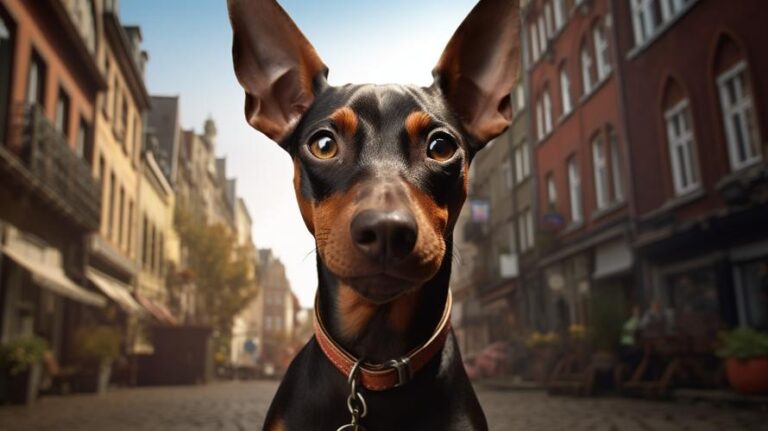Allow me to introduce you today to a unique kind of dog breed that you may not even know about – The German Pinscher. This breed is muscular, sprightly, and has a shiny, sleek fur that comes in various shades from fawn to black. But here’s the coolest part: The German Pinscher isn’t just another pretty face—they’re also known for their quick reflexes, agile movements, and keen intelligence.
But I bet you’re wondering, “So, they’re beautiful and smart. But are these dogs aggressive or not?” That’s the million-dollar question. Let’s explore together.
First off, labels can be misleading. When someone labels a dog as ‘aggressive’, what is he or she actually trying to say? The term aggressive, when applied to any dog, paints a picture of a snarling, teeth-baring beast ready to pounce at any moment. However, when dealing with German Pinschers, we should be careful about slapping on this label too quickly.
German Pinschers, by their nature, are neither aggressive nor threatening. Instead, they are a bundle of energy, curiosity, and alertness waiting to explode into action. In fact, they were originally bred in Germany to hunt vermin. It’s this hunting instinct that often gets mistaken for aggression. They are highly protective and will stop at nothing to ensure the safety of their homes and human families. Think of them more as ‘assertive’ and less as ‘aggressive’.
That being said, much of a dog’s behavior comes down to training and socialization, regardless of breed. Weiss, a famous dog psychologist, states that “there’s no such thing as bad dogs, just bad owners”. German Pinschers can certainly fall into this statistic if they’re not properly trained or socialized. Behavior such as excessive barking, biting, and being territorial can be misconstrued as aggression when in fact, these actions result from a lack of quality early life socialization and training.
The perfect antidote for preventing ‘aggressive’ behavior? Early socialization and consistent training. A German Pinscher has high energy levels contributing to the mistaken belief it’s aggressive. A good training regime ensures this energy is directed in a positive way. Socialization, on the other hand, means introducing the pup to a variety of experiences, people, and other animals to teach it how to behave appropriately.
Think of it this way – early socialization and training for your German Pinscher is like investing in a good education for your child. A well-rounded individual who knows how to deal with various situations is less likely to engage in negative, destructive, or problematic behavior, right? The same goes for your pup.
Alright, you might ask, “I’m game. But how do I go about it?”
Great question! Everyone likes a good story, so let’s borrow an interesting anecdote from a German Pinscher owner, Sarah, who transformed her once unruly German Pinscher, Randy, into a disciplined and well-behaved pet.
Sarah got Randy while he was a boisterous little puppy. At first, Randy seemed overly energetic and incredibly stubborn. Sarah was almost on the brink of giving up on training him when she realized that conventional dog training methods were proving ineffective. After plenty of research and vet advice, Sarah realized that the key to harnessing Randy’s wild energy was to engage him in mentally stimulating activities along with physical ones.
Commands were presented as fun puzzles to be solved with food-based rewards; walks included complex routes with various environments, people, and animals. Instead of demonstrating dominion over Randy, Sarah encouraged learning from experiences together. Over time, Randy underwent a drastic transformation. He became more disciplined, less destructive, and appeared ‘calmer’ to people who had previously labeled him “aggressive”.
Beyond training and socialization, there are also a few other tips to keep in mind for German Pinscher owners:
1. Provide ample physical and mental stimulation daily to prevent boredom and destructive behavior.
2. Establish a strong bond of trust and respect with your pet. This goes a long way in establishing the dog’s comfort and calmness around humans.
3. Regular health checks are essential as certain diseases or discomfort can trigger aggressive behavior in dogs.
That’s not to say German Pinschers are overly complicated breeds to manage. However, understanding their unique traits and responding appropriately to them will provide you with an immensely rewarding pet-parent experience.
The final verdict? German Pinschers are not naturally aggressive. The reinforced misconception arises largely from misinterpreted high-energy levels and wiry reflexes. However, by strategically training and socializing your German Pinscher, you can easily guide them to utilize their energy and intelligence positively.
Prime your German Pinscher with love, respect, and well-structured training, and you’re sure to have a loyal, protective, and exciting companion for life. But remember, as with any breed, the German Pinscher is not for everyone. Understanding your potential pet’s personality and aligning it with your lifestyle is crucial for a harmonious pet-human relationship.
The one thing all dog breeds have in common is their ability to love unconditionally. With a little bit of patience and a lot of affection, you can turn any ‘aggressive’ label into one of ‘enormously faithful and loving’. After all, isn’t that what we adore about these furry friends?



